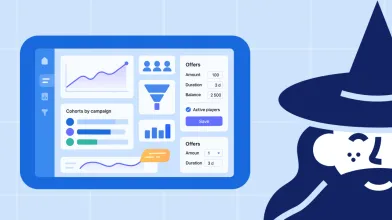Bridging the gap: optimizing collaboration between UA and product teams
February 5, 2025
In the high-stakes world of mobile apps and digital products, two roles stand out as critical for success: User Acquisition (UA) Managers and product teams. While UA managers are the architects of user traffic, tasked with driving high-quality users and maximizing return on ad spend (ROAS), product teams are the creators of experiences, focused on building engaging, user-friendly apps.
But what happens when these two forces collide? More often than not, the result is a disconnect that can hinder growth and revenue. Imagine this: your UA team is bringing in users, but the product isn’t retaining them. Or, your product is top-notch, but the marketing isn’t reaching the right audience. It’s a classic case of “right hand, meet left hand.”
In this article, we’ll explore the common challenges that UA and product teams face, the importance of bridging the gap between them, and how tools like Magify can be the game-changer you need. We’ll also dive into real-world case studies to show you how successful collaboration can transform your app’s performance.
1. Understanding Traffic Quality: The UA Perspective
UA managers are the gatekeepers of user traffic, and their primary goal is to ensure that the traffic they drive is not only high in volume but also high in quality. To evaluate traffic quality, UA managers rely on several key metrics:
- Retention Rates: The percentage of users who continue to use the app over time.
- Lifetime Value (LTV): The predicted revenue a user will generate during their lifetime.
- Conversion Rates: The percentage of users who complete a desired action, such as making a purchase or signing up.
Challenges in Proving Traffic Quality
Despite having these metrics, UA managers often face challenges in proving the quality of traffic to product teams. This is where collaboration becomes essential. By working closely with product teams, UA managers can gain insights into user behavior and product performance, allowing for more accurate assessments of traffic quality.
Real-world example: A match-3 game’s UA team noticed a high influx of users but poor retention. Collaboration with the product team revealed that the onboarding process was too complex, causing new users to drop off. By simplifying the onboarding, retention improved by 30%.
2. Identifying Poor ROAS: Speed and Accuracy
Detecting Poor ROAS Quickly
The ability to quickly identify campaigns with poor ROAS is critical for UA managers. Delayed detection can lead to wasted ad spend and missed opportunities. To address this, UA managers use a variety of tools and methods, including:
- Real-time Monitoring Dashboards: These dashboards provide instant feedback on campaign performance, allowing for quick adjustments.
- Data Analytics Platforms: Advanced analytics tools help identify trends and patterns that may indicate underperforming campaigns.
The Role of Magify
Magify, with its robust data analytics capabilities, can be a game-changer for UA managers. By integrating Magify into their workflow, managers can:
- Access real-time ROAS data across multiple channels
- Utilize AI-driven predictive analytics to forecast campaign performance
- Automate budget allocation based on performance metrics
- Generate custom reports that bridge UA and product team perspectives
For example, Magify’s cohort analysis feature allows UA managers to track user behavior over time, providing insights into how different acquisition channels impact long-term user engagement and revenue.
3. Communication Between UA and Product Teams
Impact of Product Changes on UA Performance
Product updates and new features can significantly impact UA performance. For example, a new feature may attract more users, but if it is not well-received, it can lead to higher uninstall rates. Clear and timely communication between UA and product teams is essential to address these issues.
Examples of Miscommunication
Miscommunication can lead to poor UA outcomes. For instance, if a product team launches a new feature without informing the UA team, the team may continue to drive traffic to an outdated version of the app, resulting in a poor user experience and lower conversion rates.
4. Leveraging A/B Testing for Performance Analysis
The Role of A/B Testing
A/B testing is a powerful tool for understanding the impact of product changes on UA performance. By testing different versions of a product, teams can identify which changes lead to better user engagement and higher conversion rates.
Best Practices for A/B Testing
- Clear Objectives: Define what you want to achieve with the test.
- Controlled Variables: Ensure that only one variable is changed at a time.
- Sufficient Sample Size: Ensure that the test has enough participants to be statistically significant.
- Duration: Run tests long enough to account for user behavior patterns.
- Segmentation: Test different user segments to understand varied impacts.
Case Studies
A leading gaming app used A/B testing to optimize its in-app purchase flow. By testing different layouts and pricing strategies, the app increased its conversion rate by 15%.
5. Building a Systematic Approach to Resolve Conflicts
Standardized Reports
Creating standardized reports for UA managers can help demonstrate traffic quality and facilitate communication with product teams. These reports should include key metrics and insights that highlight the impact of UA efforts on product performance.
Example report structure:
- User Behavior Metrics
- Retention rates
- Engagement metrics
- Conversion funnel analysis
- Revenue Impact
- LTV projections
- Revenue by user segment
- Action Items and Recommendations
Release Notes and Documentation
Clear documentation of product updates is crucial for UA teams. Release notes should be detailed and include information on changes that may affect UA performance.
Best practices for release notes:
- Clearly outline new features and changes
- Highlight potential impacts on user acquisition and retention
- Provide updated screenshots or demos for UA teams to use in campaigns
- Include timelines for rollout and any A/B testing plans
Transparent Workflows
Establishing transparent workflows can prevent issues like driving traffic to underperforming product versions. By implementing clear processes and communication channels, teams can ensure that everyone is on the same page.
Workflow example:
- Product team schedules update
- Joint meeting to discuss potential UA impact
- UA team prepares new creative assets
- Coordinated launch with aligned messaging
- Post-launch analysis and optimization
6. Best Practices for Collaboration
Regular Synchs
Regular meetings between UA and product teams can help align goals and expectations. These meetings should be used to discuss performance metrics, share insights, and plan future strategies.
Meeting agenda template:
- Review of key performance indicators
- Discussion of upcoming product changes
- UA campaign performance and insights
- Collaborative problem-solving session
- Action items and next steps
Shared KPIs
Using shared key performance indicators (KPIs) ensures that both teams are working toward the same objectives. For example, if the goal is to increase user retention, both teams should have KPIs that reflect this objective.
Example of shared KPIs:
- 30-day retention rate
- User acquisition cost to LTV ratio
- Feature adoption rate for new users
- Overall app store rating
Tools for Data Sharing
Implementing tools and processes for seamless data sharing and analysis is essential for effective collaboration. Magify, with its data-sharing capabilities, can be a valuable asset in this regard.
Key features of effective data-sharing tools:
- Real-time data synchronization
- Customizable dashboards for different team needs
- Automated alerts for significant metric changes
- Collaborative annotation and discussion features
7. Advanced Data Analytics Techniques
To further enhance collaboration and decision-making, both UA and product teams can leverage advanced data analytics techniques:
Predictive Analytics
Use machine learning models to forecast user behavior, churn likelihood, and potential LTV. This can help UA teams optimize their targeting and bidding strategies.
Cohort Analysis
Analyze how different user groups behave over time to understand the long-term impact of acquisition strategies and product changes.
User Segmentation
Utilize clustering algorithms to identify distinct user groups, allowing for more personalized product experiences and targeted UA campaigns.
Attribution Modeling
Implement multi-touch attribution models to understand the full user journey and allocate UA budgets more effectively.
8. Industry Trends and Future Outlook
Stay ahead of the curve by keeping an eye on emerging trends in UA and product development:
AI-Driven User Acquisition
🤖 Machine learning algorithms are increasingly being used to optimize ad targeting, bidding, and creative selection in real-time.
Personalization at Scale
🎯 Advanced personalization techniques are allowing product teams to create unique experiences for each user, improving retention and LTV.
Privacy-First UA Strategies
🕵️♂️ With increasing privacy regulations, UA teams are developing new strategies that rely less on individual user data and more on contextual and probabilistic methods.
Cross-Functional Team Structures
🤝 Some companies are experimenting with integrated teams that combine UA, product, and data science roles to foster better collaboration from the ground up.
9. Collaboration Framework: The UA-Product Synergy Model
To help organizations assess and improve their collaboration practices, we’ve developed the UA-Product Synergy Model:
- Siloed (Level 1): UA and product teams work independently with minimal communication.
- Aware (Level 2): Teams share basic information but still operate separately.
- Coordinated (Level 3): Regular meetings and shared goals, but limited joint decision-making.
- Integrated (Level 4): Shared KPIs, collaborative workflows, and joint strategy sessions.
- Synergistic (Level 5): Fully aligned teams with shared resources, cross-functional roles, and a unified approach to growth.
Organizations can use this model to identify their current level of collaboration and implement strategies to move to the next level.
10. Conclusion and Next Steps
The success of any digital product depends on the seamless collaboration between UA and product teams. By fostering a culture of open communication, leveraging advanced tools and analytics, and adopting best practices for collaboration, teams can overcome common challenges and achieve remarkable results.
Key takeaways for improving communication, transparency, and performance include:
- Align Goals and Expectations: Implement regular synchs and shared KPIs.
- Leverage Data: Utilize advanced analytics and A/B testing to drive decision-making.
- Embrace Tools: Implement robust data-sharing and analysis platforms like Magify.
- Foster Cross-Functional Understanding: Encourage knowledge sharing between UA and product teams.
- Stay Agile: Continuously adapt to industry trends and emerging technologies.
Next Steps Checklist:
✅ Assess your organization’s current level on the UA-Product Synergy Model
✅ Set up a joint UA-Product task force to identify collaboration pain points
✅ Implement a shared dashboard for key metrics using a tool like Magify
✅ Establish a regular cadence of cross-functional meetings and workshops
✅ Develop a standardized process for communicating product updates to the UA team
✅ Create a joint quarterly strategy session to align long-term goals and initiatives
By adopting a more integrated approach and leveraging the right tools, UA and product teams can unlock the full potential of their efforts, driving sustainable growth and creating exceptional user experiences.
Remember, the journey to perfect collaboration is ongoing. Continuously seek feedback, iterate on your processes, and stay curious about new ways to bridge the gap between user acquisition and product development. The future of your app’s success depends on it.



